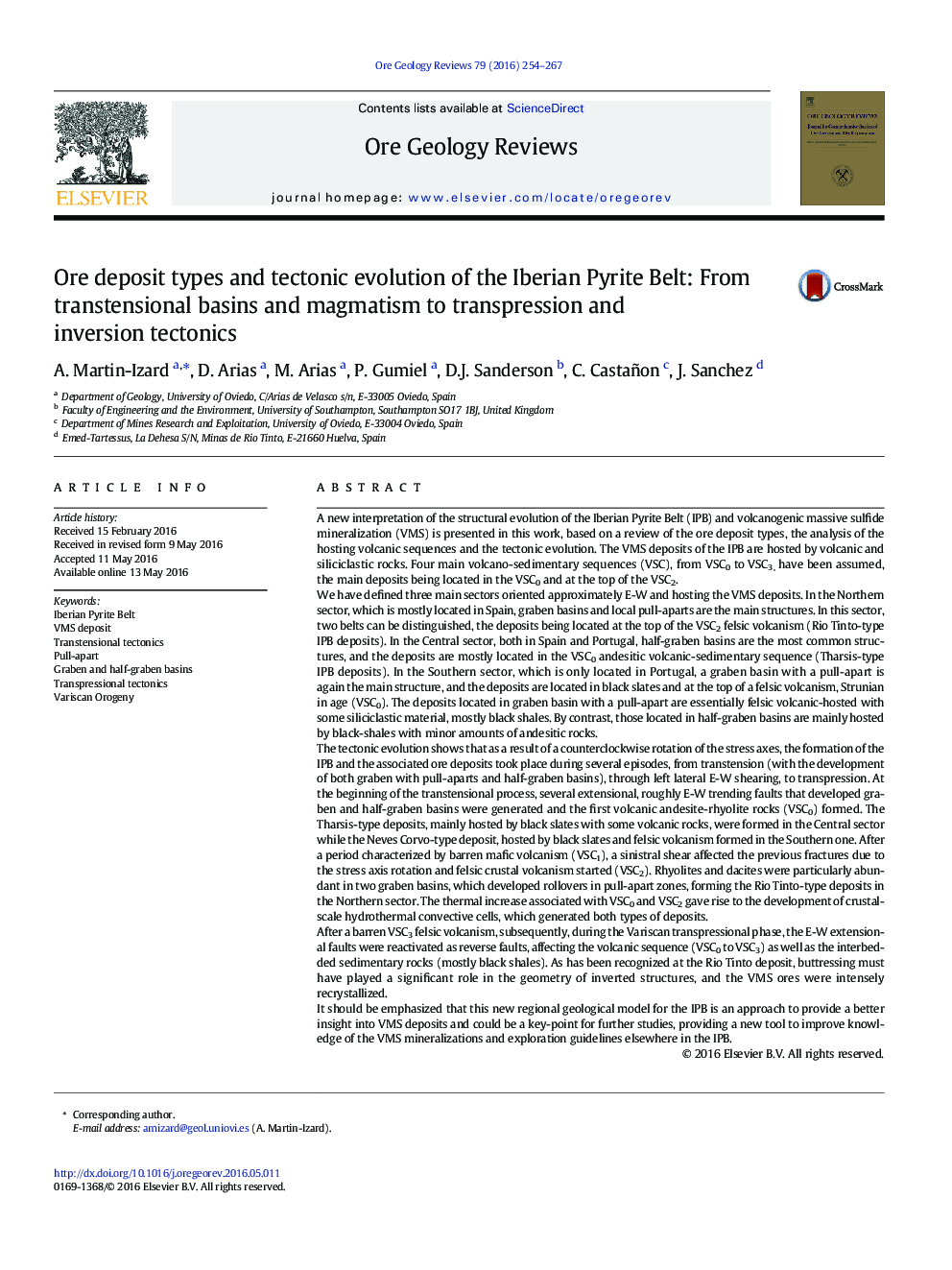| کد مقاله | کد نشریه | سال انتشار | مقاله انگلیسی | نسخه تمام متن |
|---|---|---|---|---|
| 4696796 | 1637227 | 2016 | 14 صفحه PDF | دانلود رایگان |
• A new interpretation of the structural evolution of the Iberian Pyrite Belt (IPB)
• Review of main deposits, sedimentary-volcanic sequences and tectonic characteristics
• Geological mapping and cross and balanced sections defining three main VMS sectors
• Relationships between ores and transtensional grabens, half-graben and pull-aparts
• A new tool to increase knowledge of VMS ores and exploration guidelines in the IPB.
A new interpretation of the structural evolution of the Iberian Pyrite Belt (IPB) and volcanogenic massive sulfide mineralization (VMS) is presented in this work, based on a review of the ore deposit types, the analysis of the hosting volcanic sequences and the tectonic evolution. The VMS deposits of the IPB are hosted by volcanic and siliciclastic rocks. Four main volcano-sedimentary sequences (VSC), from VSC0 to VSC3, have been assumed, the main deposits being located in the VSC0 and at the top of the VSC2.We have defined three main sectors oriented approximately E-W and hosting the VMS deposits. In the Northern sector, which is mostly located in Spain, graben basins and local pull-aparts are the main structures. In this sector, two belts can be distinguished, the deposits being located at the top of the VSC2 felsic volcanism (Rio Tinto-type IPB deposits). In the Central sector, both in Spain and Portugal, half-graben basins are the most common structures, and the deposits are mostly located in the VSC0 andesitic volcanic-sedimentary sequence (Tharsis-type IPB deposits). In the Southern sector, which is only located in Portugal, a graben basin with a pull-apart is again the main structure, and the deposits are located in black slates and at the top of a felsic volcanism, Strunian in age (VSC0). The deposits located in graben basin with a pull-apart are essentially felsic volcanic-hosted with some siliciclastic material, mostly black shales. By contrast, those located in half-graben basins are mainly hosted by black-shales with minor amounts of andesitic rocks.The tectonic evolution shows that as a result of a counterclockwise rotation of the stress axes, the formation of the IPB and the associated ore deposits took place during several episodes, from transtension (with the development of both graben with pull-aparts and half-graben basins), through left lateral E-W shearing, to transpression. At the beginning of the transtensional process, several extensional, roughly E-W trending faults that developed graben and half-graben basins were generated and the first volcanic andesite-rhyolite rocks (VSC0) formed. The Tharsis-type deposits, mainly hosted by black slates with some volcanic rocks, were formed in the Central sector while the Neves Corvo-type deposit, hosted by black slates and felsic volcanism formed in the Southern one. After a period characterized by barren mafic volcanism (VSC1), a sinistral shear affected the previous fractures due to the stress axis rotation and felsic crustal volcanism started (VSC2). Rhyolites and dacites were particularly abundant in two graben basins, which developed rollovers in pull-apart zones, forming the Rio Tinto-type deposits in the Northern sector. The thermal increase associated with VSC0 and VSC2 gave rise to the development of crustal-scale hydrothermal convective cells, which generated both types of deposits.After a barren VSC3 felsic volcanism, subsequently, during the Variscan transpressional phase, the E-W extensional faults were reactivated as reverse faults, affecting the volcanic sequence (VSC0 to VSC3) as well as the interbedded sedimentary rocks (mostly black shales). As has been recognized at the Rio Tinto deposit, buttressing must have played a significant role in the geometry of inverted structures, and the VMS ores were intensely recrystallized.It should be emphasized that this new regional geological model for the IPB is an approach to provide a better insight into VMS deposits and could be a key-point for further studies, providing a new tool to improve knowledge of the VMS mineralizations and exploration guidelines elsewhere in the IPB.
Figure optionsDownload as PowerPoint slide
Journal: Ore Geology Reviews - Volume 79, December 2016, Pages 254–267
